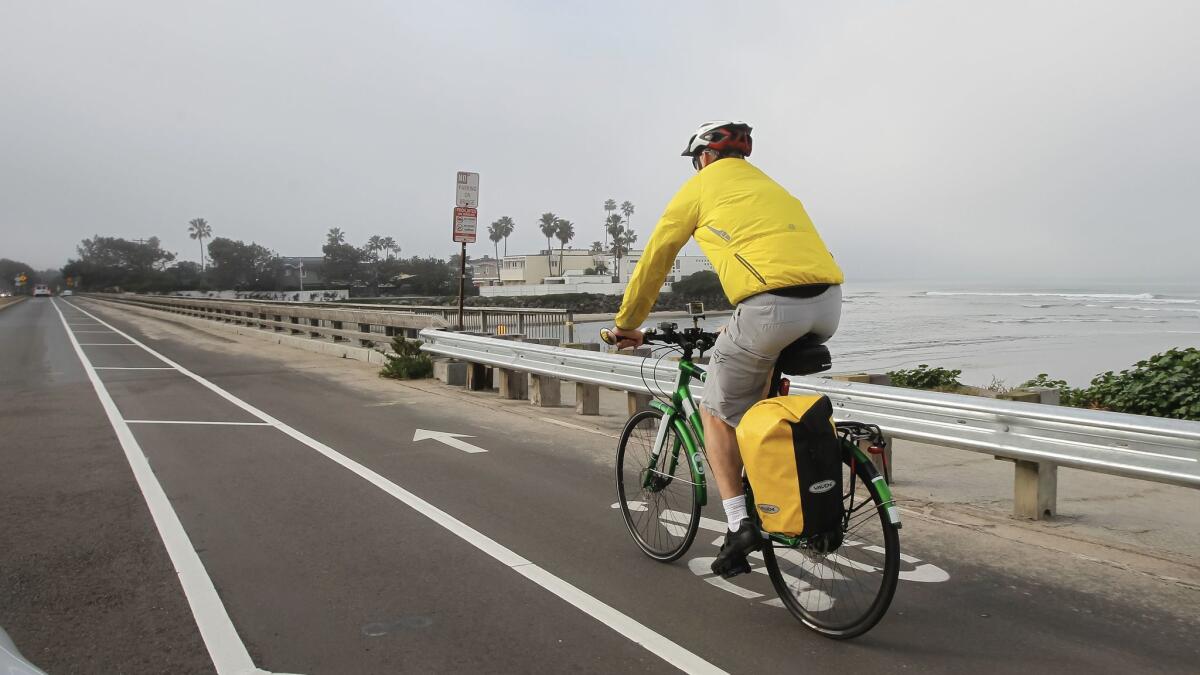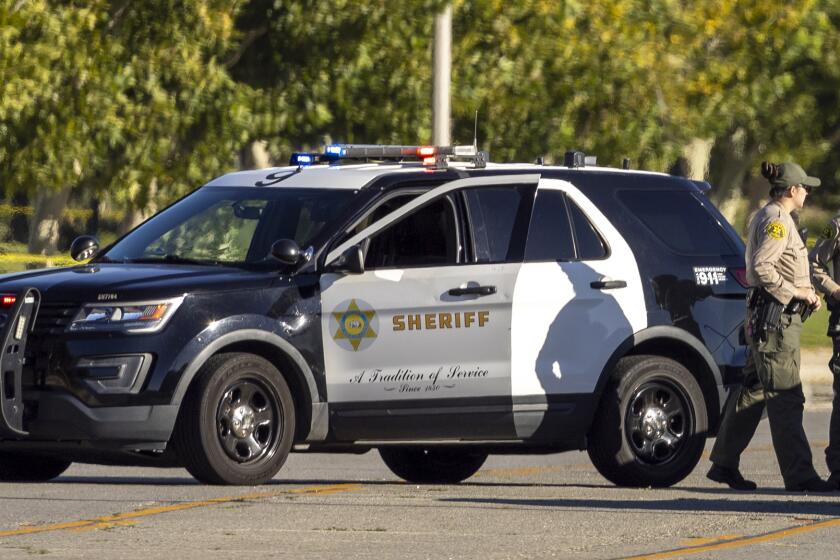Can bikes and cars share a scenic San Diego coastal road? There have been some bumps along the way

- Share via
In the coastal cities north of San Diego, there’s a growing movement to transform Coast Highway 101 into a more bicycle-friendly thoroughfare.
But that effort has hit some rough spots as commuters on two and four wheels struggle to share the road.
From Del Mar to Oceanside, cities are looking to slow traffic, widen bike lanes and implement other changes that encourage people to get out of their cars and use alternative forms of transportation. The reaction isn’t always pretty.
“I’ve had people yell at me that the road is for cars,” said Michael Faulstich, who rides a bike from his home in Encinitas to work at the Salk Institute in La Jolla most weekdays. “They don’t get it that I’m just another vehicle.”
Del Mar resident David Shannahoff-Khalsa said trying to put bikes on equal footing with cars is ridiculous.
“Traffic is already severe,” he said. “Why make a bottleneck? We have to have some kind of common sense.”
Solana Beach finished an overhaul of its portion of Coast Highway in 2013, completing a $7 million project that converted the road to narrower lanes with wide sidewalks, gathering spaces and buffered bike lanes.
Encinitas made changes in Leucadia, reducing traffic lanes and adding “sharrows” — large white markers painted on the asphalt — to remind drivers to slow down and share the lane.
Del Mar and Oceanside are studying similar changes, hoping to better accommodate bicyclists and pedestrians and create a more vibrant environment for businesses and residents along the coast.
The changes are praised by urban planners like Dan Burden who say they signal the start of “a whole new era for transportation.”
“The future is about building our cities for people,” said Burden, who spoke Thursday at a Carlsbad forum on the past, present and future of Highway 101. Cars will still be accommodated, he said, but streets should be designed to encourage people to drive slower and safer, and to reward them for taking short trips instead of long ones.
Not everyone is there yet. After a re-striping pilot program was launched last year in Oceanside — reducing parts of Coast Highway from two to four lanes, and adding wider bike lanes — more than 400 people signed a petition against the changes.
Led by a group called Save South O, they said a narrower road might work in a touristy area like downtown but not in a neighborhood where the road is frequented by locals headed to work or home.
“The entire corridor is not the same in terms of residents and businesses,” South Oceanside resident Joel West told the City Council in November. “Our neighborhood does not have a pier or high-rise hotels…. We depend on Coast Highway for circulation.”
In fact, Highway 101 was built nearly a century ago to get cars between San Diego and Los Angeles as quickly as possible. Interstate 5 took over that job in the 1960s, but it’s now choked with traffic during the morning and evening commutes — prompting San Diego motorists to cut over to Coast Highway as an alternate route.
A backup freeway isn’t the vision that city planners have for the historic road. Instead of escorting drivers out of town, they see the coastal route as a way to invite people in, to stop and shop, ride bicycles, enjoy the beach, and maybe meet some new people or old friends.
Leaders of the region’s robust cycling community say slowing traffic and improving bike lanes along Highway 101 will ultimately improve the quality of life for all.
“It’s all a really positive direction,” said Andy Hanshaw of the San Diego County Bicycle Coalition. “We think it makes sense for safety, and certainly for climate impacts, reducing greenhouse gases.”
But Del Mar is another town where the idea has run into trouble. City planners have proposed reducing northbound Camino del Mar — the name for Coast Highway in that city — from two lanes to one between Carmel Valley Road and Fourth Street. That prompted a letter-writing campaign by residents early this year.
A few supported the plan, but most said the narrower road would worsen congestion and force more traffic onto the parallel residential street of Stratford Court.
“With more vehicle traffic, it would become less safe for pedestrians,” wrote Del Mar resident Terence Morgan, adding that the slower traffic would increase air pollution from idling cars.
At a Feb. 6 meeting, the Del Mar City Council agreed to study the idea further before taking any action.
In Solana Beach, many residents have embraced the reshaped road and agree that it’s more welcoming to cyclists, pedestrians and shoppers.
“People who come to Solana Beach, they are really impressed with what the community has done,” said Douglas Alden. He said he rides his bicycle from his home in Solana Beach three or four days a week to work as a development engineer at Scripps Institution of Oceanography in La Jolla.
As in Del Mar and Oceanside, some residents initially resisted the changes, particularly the sharrows, Alden said. He remembers some honking horns and angry shouts.
But “everyone is used to it now,” he said. “People are resistant to change. That’s just typical.”
The city also has benefited economically from the project, according to Kathleen Ferrier of Circulate San Diego, a nonprofit that promotes “complete streets” designed to be accessible for all travel modes — driving, bicycling, walking and public transit.
Retail sales increased an average of 10 percent in Solana Beach after it made its improvements, said Ferrier, who also spoke at the Carlsbad forum.
“More narrow travel lanes really make it safer,” she said, because vehicles go slower and there’s room for wider sidewalks and bicycle lanes. Traffic experts say slower speeds on local roads add little time to a commute — at most two or three minutes — while they greatly increase safety for everyone.
Faulstich, who’s been making his bicycle commute from Encinitas to La Jolla for about 10 years, said he hopes more cities will get on the bandwagon in redesigning their roadways.
“What I would like to see is a little more consistency,” Faulstich said. “You have this mixture of good infrastructure that is bike friendly, then you have these sections that are a free-for-all.”
philip.diehl@sduniontribune.com
Phil Diehl writes for the San Diego Union-Tribune.
More to Read
Sign up for Essential California
The most important California stories and recommendations in your inbox every morning.
You may occasionally receive promotional content from the Los Angeles Times.













